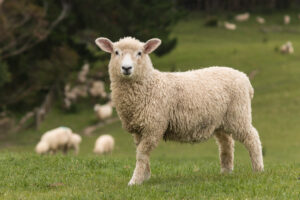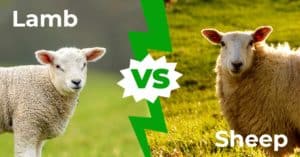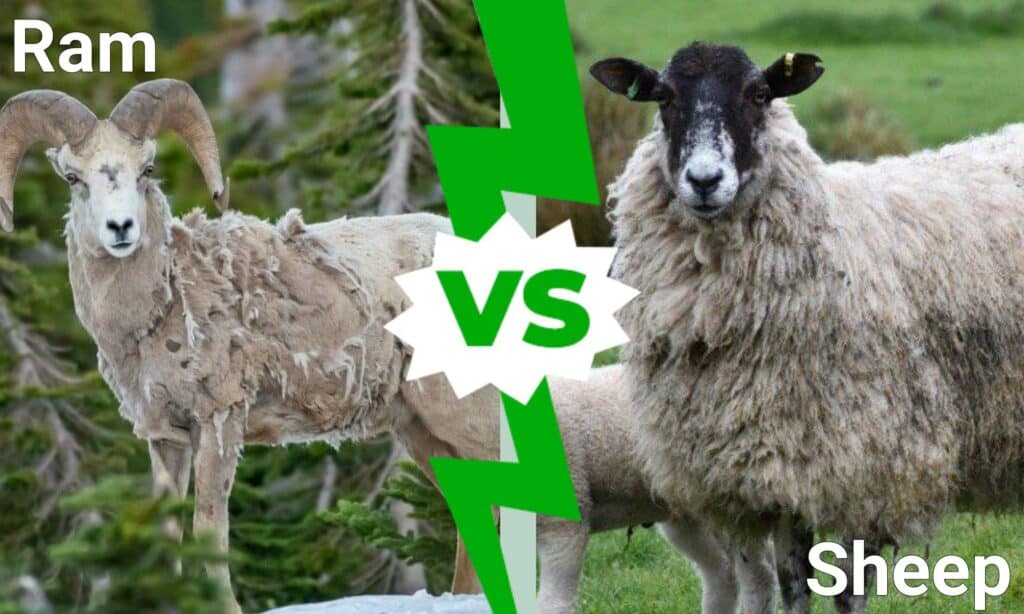
Answering the question of what the difference is between Rams VS Sheep, the answer is clear because they are the same thing! Ram is the name given to a male sheep, and female sheep are called Ewes. Lambs are baby sheep, but whether lamb, ewe, or ram, they are all the same animal! The main difference between a male and female sheep is that while females may have horns, the males are significantly longer and thicker.
However, this is only one of the ways you can tell a Ram from an Ewe. Sheep are one of the first domesticated animals, and we know a great deal about the species. Physically, the two sexes are easy to tell apart, but they also have quite diverse ways of expressing themselves!
Male VS Female Sheep: Physical Differences To Look For

Rams and Ewes can both have horns, but males are much longer and thicker. Males also have visible male genitalia and lack teats.
©John Raptosh/Shutterstock.com
Male and female sheep are extremely easy to tell apart, even without the ram’s impressive horns! Coincidentally, female sheep often have horns as well, but some domesticated species do not. Both males and females are usually between 4-5 feet long and 2-3 feet high, which varies by species.
While males and females have some physical similarities, there are just as many differences. These differences are so easy to spot that you do not have to rely on horns to tell them apart!
Identifying A Ram: Physical Characteristics
Adult Rams are a bit heavier than females and can weigh up to 350 pounds. The easiest way to tell if a sheep is male is by looking at the horns. Though both male and female sheep can have horns, a ram will be significantly longer and thicker in diameter. The size of the horns varies by species and the Bighorn Sheep’s horns can weigh up to 30 pounds!
Males can also be easily identified by the presence of visible male genitalia. This characteristic is harder to spot in incredibly young lambs but still detectable.
Identifying An Ewe: Physical Characteristics
Adult ewes are lighter than males and usually weigh up to 220 pounds. Identifying a female sheep is also simple, even if the female has horns. Ewes will lack the obvious male genitalia, and the horns will be much smaller if present.
Female sheep also have two teats, which rams do not have. These teats are present and recognizable from birth, and female lambs are easier to identify. Adult ewes will also develop a fist-sized udder in the abdomen before giving birth. When this happens, a lamb is on the horizon!
Male VS Female Sheep: Temperament And Behavior

Both rams and ewes are highly social, gentle animals that like to be together. However, rams will compete during mating season, and ewes are highly protective of their lambs.
©N-sky/Shutterstock.com
One of the reasons sheep were among the first animals domesticated by humans is their gentle temperament. Sheep are docile and intelligent animals that form family groups and herds, and both males and females are quite social. Both wild and domesticated sheep stick together, and domestic sheep are believed to recognize their owners as family members!
Though both males and females are social, there are some key differences between the two related to temperament and behavior.
Rams Are More Aggressive And Territorial
Rams function as both protection and leadership, and in the wild, the rams are responsible for fending off predators. The number of rams in a herd depends on the herd’s size, but there are always fewer rams than ewes.
Therefore, rams tend to be more aggressive and territorial than females. However, this only applies to predators or other males during the rutting season, and rarely ends in death. Rams will compete with other males for status and the right to mate. Challenges involve kicking, biting, or “locking horns” and end when the loser submits. The largest males with the most impressive horns are not often challenged.
Ewes Are More Docile, But Protective
Ewes are docile and do not compete for status as rams do. Females have clear leaders based on size and will usually choose to flee a predator. However, high-ranking females will challenge a predator to protect the herd or their lambs. They will stomp the ground, kick, bite, and attack with horns if they have them! Females rarely if ever fight and are more easygoing both in the wild and in domestication.
Sheep Are Herd Animals With A Social Structure!
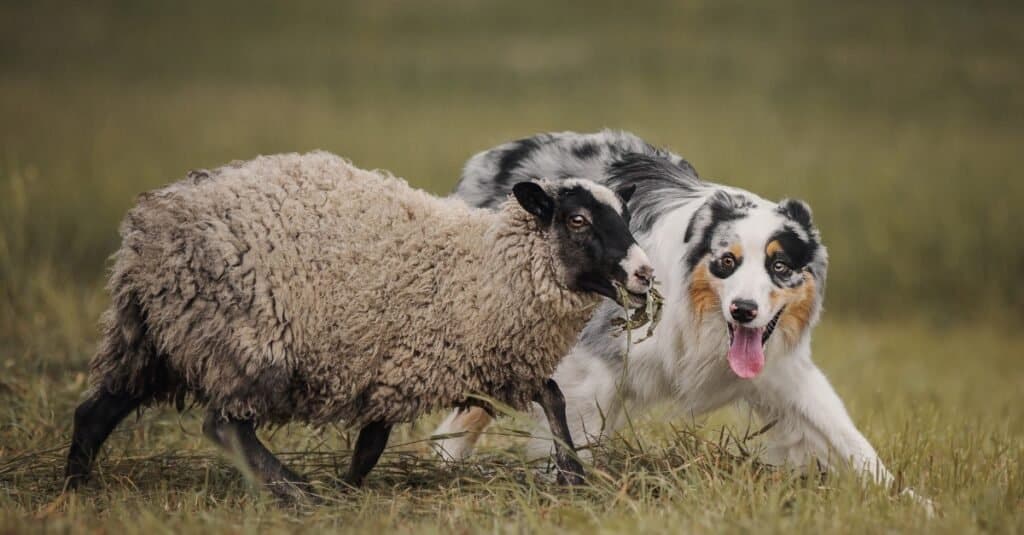
Sheep are a herd species, and both males and females will suffer if isolated from other sheep.
©iStock.com/Julia_Siomuha
Like horses, sheep are herd species and form social groups to protect them from predators. Herds and groups are similar to human families, and many experts think sheep may also see human caretakers and even dogs as family members. Most sheep herds have one or two rams and several females. Sheep of both sexes are known to experience extreme levels of stress and anxiety when isolated. Loneliness can cause such elevated levels of stress that the animal can die from isolation. Owners of domesticated sheep are strongly advised to have more than one!
Herds of sheep have a distinct social structure where the largest and tallest sheep with the biggest horns are at the top. This ranking system applies to both males and females and both wild and domesticated sheep. There are some differences between the social ranking for rams and ewes.
Rams May Change Herds But Are Not Solitary
While males are known to be transient and may move from herd to herd, they are rarely fully solitary. A ram may relocate to another herd to improve its chances to mate if too many males are present. Fully mature rams will often fight for dominance, but this only happens during the rut. Otherwise, rams coexist peacefully, and fighting rarely results in death. Males may form transient and unstable groups if females are not present.
Ewes Have A Social Ranking But Usually Do Not Compete
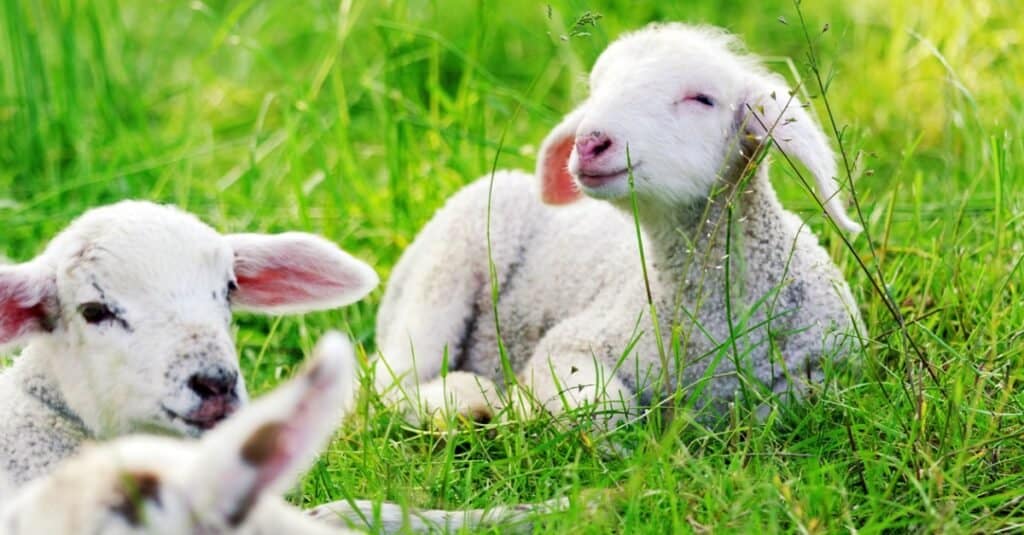
Since females form strong maternal groups in the herd, female lambs will stay with their mother and female family members after weaning. Rams tend to drift into groups of other males until mating.
©iStock.com/Matthäus Rojek
Females also have a hierarchy based on the same rules for status as Rams. Females do not compete for mating rights, but males will compete more heavily for the highest-ranking females. Ewes will form close maternal groups that often last for their entire lives, and one herd may have several groups of females. After weaning, female lambs stay in the maternal group. Even domesticated females that are taken from the dam for weaning return to the group. Groups of females can include lambs, mothers, and even great-grandmothers!
The photo featured at the top of this post is © Paul Steven/Shutterstock.com
Thank you for reading! Have some feedback for us? Contact the AZ Animals editorial team.




